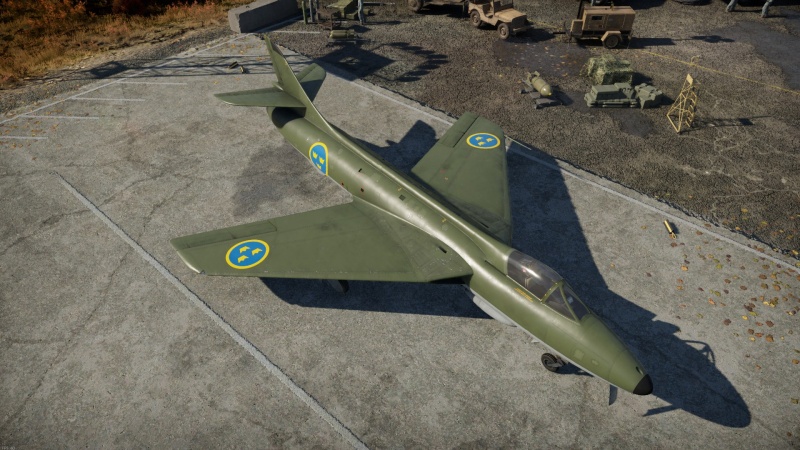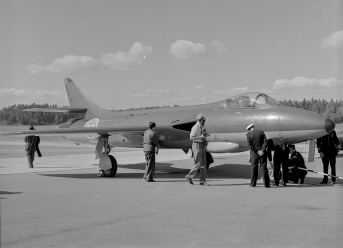J34
Contents
Description
The Hunter Mk.50 (designated the J34) was acquired by Sweden in 1954, after being considered for an interceptor aircraft that would mainly attack bombers at high altitudes. The J34 could be considered as a stop gap while the J35 Draken was still in development. While the J29 Tunnan was the backbone of the Swedish Air Force, the Hunter was deployed around Stockholm to protect the capital from incoming bombers. It was given to the F8 and F18 air wings and, while it retained its standard armament, it was also armed with the RB24 air-to-air missile. The J34's biggest flaw proved to be its lack of radar, this meant successful interceptions could only happen in daytime and with clear skies (this probably motivated SAAB to give the J35 Draken all-weather capabilities). Sweden acquired 120 J34s; they started to be phased out in favour of the more modern J35 in the 1960s, being given to less prominent air wings like the F9 and F10 squadrons. The last J34 in service was retired in 1969.
Introduced in Update "Fire and Ice", the J34, like all Hunters, is a very capable subsonic fighter, it sits in the transonic area, where its speed is very close to breaking the sound barrier. Topping out at 1109 km/h when fully upgraded, you will see yourself out speeding even supersonic fighters. This is because the J34 has a very good acceleration above 700 km/h. Its armament is also very capable against air targets, the four 30 mm ADEN cannons can destroy most aircraft with a short burst, while the RB24 missiles are very useful to attack enemies that are distracted or moving slow. You also hold your energy pretty well, being capable to energy trap aircraft like the MiG-21, Milan and other delta wing fighters with ease, however it should be noted that the manoeuvrability below 700 km/h is very bad, and since the aircraft lacks countermeasures, staying fast and agile is your best chance to stay alive.
General info
Flight performance
The J34 is a transonic jet fighter, powered by the Rolls-Royce Avon Mk115 engine. Reaching speeds up to 1,109 km/h at sea level, with the capability of reaching Mach 1 in a dive. Performing similarly to the Hunter F.1, the J34 works best at high speed. Above 700 km/h is where manoeuvrability and climb rate are best, though overheating can become an issue when at 100% throttle for extended periods of time. Despite lacking an afterburner, a decent climb rate of 56 m/s can be used for getting the drop on other jets with relative ease. Extended turning should be avoided as the J34 loses speed quickly when turning. Falling victim to the similar flaws of other Hunters, the high stall speed can get an unprepared pilot into a punching bag for other fighters such as Sabres or MiGs. Combat flaps help with manoeuvring when below 600 km/h IAS where the plane begins to struggle, but may still be ineffective in comparison. The airbrake is effective but is located on the underside of the fuselage and can't be used when the landing gear is deployed.
| Characteristics | Max speed (km/h at 0 m - sea level) |
Max altitude (metres) |
Turn time (seconds) |
Rate of climb (metres/second) |
Take-off run (metres) | |||
|---|---|---|---|---|---|---|---|---|
| AB | RB | AB | RB | AB | RB | |||
| Stock | 1,099 | 1,093 | 31.9 | 33.3 | 44.9 | 40.5 | 820 | |
| Upgraded | 1,118 | 1,109 | 30.4 | 31.0 | 68.6 | 56.0 | ||
Details
| Features | |||||
|---|---|---|---|---|---|
| Combat flaps | Take-off flaps | Landing flaps | Air brakes | Arrestor gear | Drogue chute |
| ✓ | ✓ | ✓ | ✓ | X | X |
| Limits | ||||||
|---|---|---|---|---|---|---|
| Wings (km/h) | Gear (km/h) | Flaps (km/h) | Max Static G | |||
| Combat | Take-off | Landing | + | - | ||
| 1,193 | 603 | 581 | 465 | ~12 | ~5 | |
| Optimal velocities (km/h) | |||
|---|---|---|---|
| Ailerons | Rudder | Elevators | Radiator |
| < 850 | < 600 | < 650 | N/A |
Engine performance
| Engine | Aircraft mass | ||||
|---|---|---|---|---|---|
| Engine name | Number | Basic mass | Wing loading (full fuel) | ||
| Rolls-Royce Avon Mk.115 | 1 | 6,309 kg | 238 kg/m2 | ||
| Engine characteristics | Mass with fuel (no weapons load) | Max Gross Weight | |||
| Weight (each) | Type | 4m fuel | 15m fuel | ||
| 1,050 kg | Axial-flow turbojet | 6,666 kg | 7,499 kg | 7,799 kg | |
| Maximum engine thrust @ 0 m (RB/SB) | Thrust to weight ratio @ 0 m (100%) | ||||
| Condition | 100% | WEP | 4m fuel | 15m fuel | MGW |
| Stationary | 3,469 kgf | N/A | 0.52 | 0.46 | 0.44 |
| Optimal | 3,837 kgf (1,193 km/h) |
N/A | 0.58 | 0.51 | 0.49 |
Survivability and armour
- 64 mm Bulletproof glass - Armoured windscreen
- 12.7 mm Steel - Armour plate behind the pilot
Modifications and economy
Armaments
Offensive armament
The J34 is armed with:
- 4 x 30 mm ADEN cannons, chin-mounted (150 rpg = 600 total)
Suspended armament
The J34 can be outfitted with the following ordnance:
- Without load
- 2 x RB24 missiles
Usage in battles
With powerful guns and a high top speed, the J34 does excel at Boom & Zoom tactics.
Side climbing at a 10° angle to get high altitudes is ideal, as going head first into engagements can overwhelm the J34. When engaging multiple opponents it's best to try to run, as turning would lose too much speed to continue engaging. Dropping in on already busy or unsuspecting jet to fire an RB24 missile or with cannons is an effective method of attack.
The 30 mm ADEN cannons easily tear apart other jets, with the four cannons achieving a one-second burst mass of 21 kg. Carrying 600 rounds of ammo (150 rpg), it can quickly expend all the ammunition. Quick bursts greatly help conserve ammo while still doing devastating damage, with the tracers and onboard rangefinding radar aiding in landing shots.
Radars
The J34 is equipped with an AN/APG-30 rangefinding radar, though it is not physically modelled. It detects other planes within range and is helpful for close range aiming.
| AN/APG-30 - Rangefinding radar | |||
|---|---|---|---|
| Maximum Tracking Range |
Minimum Tracking Range |
Azimuth Tracking Angle |
Elevation Tracking Angle |
| 2,750 m | 300 m | ±9° | ±9° |
Pros and cons
Pros:
- Powerful cannons
- Effective airbrake
- Decent acceleration at high speed
- Can outrun most jets when in a climb
- Access to RB24 missiles
- Very good top speed for a subsonic jet
- Good energy retention in dogfights
Cons:
- Poor manoeuvrability, especially at low speeds
- Engine is prone to overheating fast
- Difficult in uptiers
- No flares or chaff
- Large target
History
In the 1950s and after developing the J29 Tunnan, the Swedish Air Force needed a high speed interceptor capable of intercepting enemy bombers at high altitudes, mostly Soviet Designs, that at the time, could still be intercepted by subsonic aircraft. While the J29 formed the backbone of the Swedish Air Force, the Hawker Hunter was employed in the interception role, but it was also used in patrols and if needed, in air-to-air combat.
Thus the Swedish Air Force acquired a total of 120 units of the Mk.50 variant (very similar to the Mk.4) in 1959. The Hunter was designated J34 and assigned to the F8 and F18 fighter wings defending Stockholm. The aircraft retained the same armament as the British variant (4 x ADEN 30 mm cannons) but was also fitted with AIM-9 Sidewinder missiles.
The J34 could be considered a stop gap between the J29 Tunnan and the J35 Draken (both aircraft designed and made in Sweden by SAAB). The aircraft's deliveries started in 1955 and finished relatively fast, two years later. One of its biggest downsides was the lack of radar, making interceptions viable just during the day and with clear skies. However, it was much faster than the J29, and even being subsonic, its maximum speed was very close to breaking the sound barrier (1150 km/h), all of this provided by the powerful Rolls-Royce Avon 23 (RM 5B) engine
In the 1960s, the J34 was phased out in favour of the supersonic, all-weather fighter, the J35 Draken. Thus it was given to the F9 and F10 air wings, that were less prominent, meanwhile, it was also used by the Swedish Air Force's aerobatic team Acro Hunter, using five J34s. A project to modernize the J34 was considered in 1958, being fitted with a Swedish-made engine (with an afterburner) but since the only improvement was to the flight performance, and the J35 Draken had much superior electronics, navigation equipment, and armament, the project was cancelled, and the last J34 was retired in 1969.
Media
- Skins
See also
- Related development
External links
Paste links to sources and external resources, such as:
| Hawker Aircraft Limited | |
|---|---|
| Biplane fighters | |
| Fury | Fury Mk I · Fury Mk II |
| Nimrod | Nimrod Mk I · Nimrod Mk II |
| Scout plane | Osprey Mk IV |
| Piston fighters | |
| Hurricane | Hurricane Mk I/L · Hurricane Mk.I/L FAA M · Sea Hurricane Mk IB · Sea Hurricane Mk IC · Hurricane Mk IIB/Trop · Hurricane Mk IV |
| Typhoon | Typhoon Mk Ia · Typhoon Mk Ib · Typhoon Mk Ib/L |
| Tempest | Tempest Mk V · Tempest Mk V (Vickers P) · Tempest Mk II |
| Fury | Sea Fury FB 11 |
| Jet fighters | |
| Hunter | Hunter F.1 · Hunter F.6 · Hunter FGA.9 |
| Sea Hawk | Sea Hawk FGA.6 |
| Harrier | Harrier GR.1 · Harrier GR.3 |
| Export | ▄Hurricane Mk I/L · ▂Hurricane Mk IIB · ◘Sea Fury FB 51 |
| ◘Sea Hawk Mk.50 · ◄Sea Hawk Mk.100 · ◘Hunter F.6 · ◌Hunter F.58 · J34 · AV-8A · AV-8C · ▄AV-8S | |
| Captured | ▀Tempest Mk V |
| See Also | Fokker |
| Sweden jet aircraft | |
|---|---|
| Fighters | J21RA |
| J29A · A29B · J29D · J29F | |
| J32B | |
| J34 | |
| J35A · J35D | |
| JA37C · JA37D · JA37DI · JA37DI F21 | |
| JAS39A · JAS39C | |
| Strike aircraft | A21RB |
| A32A · A32A Röd Adam | |
| A28B | |
| AJ37 · AJS37 | |
| SK60B · SAAB-105G | |
| Export | SAAB-105OE |
| Finland | ▄Vampire FB 52A · ▄MiG-21bis · Saab J35XS |






